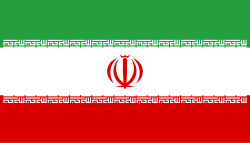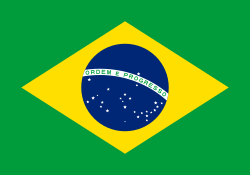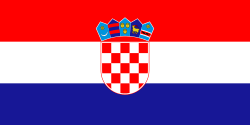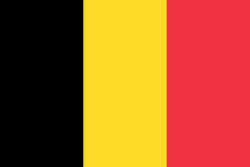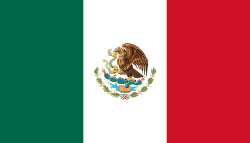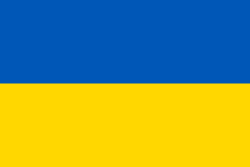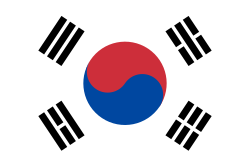Olympische Jugend-Sommerspiele 2014/Taekwondo
| Taekwondo bei den II. Olympischen Jugend-Sommerspielen | |||
|---|---|---|---|
| |||
| Informationen | |||
| Teilnehmer: | 100 Athleten | ||
| Datum: | 17. August–21. August | ||
| Austragungsort: | |||
| Wettkampfort: | Nanjing | ||
| Entscheidungen: | 10 | ||
| ← Singapur 2010 | Buenos Aires 2018 → | ||
| Olympische Jugend-Sommerspiele 2014 (Medaillenspiegel Taekwondo) | |||||
|---|---|---|---|---|---|
| Platz | Mannschaft | Gesamt | |||
| 1 | 2 | 1 | 1 | 4 | |
| 2 | 2 | — | 1 | 3 | |
| 3 | 1 | 1 | — | 2 | |
| 4 | 1 | — | 1 | 2 | |
| 5 | 1 | — | — | 1 | |
| 1 | — | — | 1 | ||
| 1 | — | — | 1 | ||
| 1 | — | — | 1 | ||
| 9 | — | 1 | 2 | 3 | |
| 10 | — | 1 | 1 | 2 | |
| — | 1 | 1 | 2 | ||
| — | 1 | 1 | 2 | ||
| — | 1 | 1 | 2 | ||
| — | 1 | 1 | 2 | ||
| 15 | — | 1 | — | 1 | |
| — | 1 | — | 1 | ||
| 17 | — | — | 4 | 4 | |
| 18 | — | — | 2 | 2 | |
| 19 | — | — | 1 | 1 | |
| — | — | 1 | 1 | ||
| — | — | 1 | 1 | ||
| — | — | 1 | 1 | ||
Bei den Olympischen Jugend-Sommerspielen 2014 in der chinesischen Metropole Nanjing wurden zehn Wettbewerbe im Taekwondo ausgetragen.
Die Wettbewerbe fanden vom 17. bis zum 21. August im Nanjing International Expo Center statt.
Jungen
Bis 48 kg
Die Wettkämpfe fanden am 17. August statt.[1]
Bis 55 kg
Die Wettkämpfe fanden am 18. August statt.[2]
Bis 63 kg
| Platz | Land | Athlet |
|---|---|---|
| 1 | Edival Pontes | |
| 2 | Jose Ruben Nava Rodriguez | |
| 3 | Nabil Ennadiri | |
| Christian McNeish |
Die Wettkämpfe fanden am 19. August statt.[3]
![]() Eduard Frankford schied im Viertelfinale aus.
Eduard Frankford schied im Viertelfinale aus.
Bis 73 kg
| Platz | Land | Athlet |
|---|---|---|
| 1 | Said Guliyev | |
| 2 | Hamza Adnan Karim | |
| 3 | Seif Eissa | |
| Danial Salehimehr |
Die Wettkämpfe fanden am 20. August statt.[4]
Über 73 kg
Die Wettkämpfe fanden am 21. August statt.[5]
Mädchen
Bis 44 kg
| Platz | Land | Athletin |
|---|---|---|
| 1 | Panipak Wongpattanakit | |
| 2 | Ceren Ozbek | |
| 3 | Chen Zih-Ting | |
| Abigail Stones |
Die Wettkämpfe fanden am 17. August statt.[6]
![]() Giuliana Federici schied im Viertelfinale aus.
Giuliana Federici schied im Viertelfinale aus.
Bis 49 kg
| Platz | Land | Athletin |
|---|---|---|
| 1 | Huang Huai-Hsuan | |
| 2 | Indra Craen | |
| 3 | Mitzi Yemaima Carrillo Osorio | |
| Zhan Tian Rui |
Die Wettkämpfe fanden am 18. August statt.[7]
Bis 55 kg
Die Wettkämpfe fanden am 19. August statt.[8]
![]() Madeline Folgmann schied im Achtelfinale aus.
Madeline Folgmann schied im Achtelfinale aus.
Bis 63 kg
| Platz | Land | Athletin |
|---|---|---|
| 1 | Kimia Alisadeh | |
| 2 | Yulia Turutina | |
| 3 | Debbie Natalia Yopasa Gomez | |
| Zhang Chen |
Die Wettkämpfe fanden am 20. August statt.[9]
Über 63 kg
Die Wettkämpfe fanden am 21. August statt.[10]
Einzelnachweise
- ↑ Event - Overview - Men -48kg ( vom 20. August 2014 im Internet Archive)
- ↑ Event - Overview - Men -55kg ( vom 20. August 2014 im Internet Archive)
- ↑ Event - Overview - Men -63kg ( vom 24. August 2014 im Webarchiv archive.today)
- ↑ Event - Overview - Men -73kg ( vom 23. August 2014 im Internet Archive)
- ↑ Event - Overview - Men +73kg ( vom 27. August 2014 im Internet Archive)
- ↑ Event - Overview - Women -44kg ( vom 20. August 2014 im Internet Archive)
- ↑ Event - Overview - Women -49kg ( vom 20. August 2014 im Internet Archive)
- ↑ Event - Overview - Women -55kg ( vom 22. August 2014 im Internet Archive)
- ↑ Event - Overview - Women -63kg ( vom 23. August 2014 im Internet Archive)
- ↑ Event - Overview - Women +63kg ( vom 27. August 2014 im Internet Archive)
Auf dieser Seite verwendete Medien
Olympic Rings without "rims" (gaps between the rings), As used, eg. in the logos of the 2008 and 2016 Olympics. The colour scheme applied here was specified in 2023 guidelines.
Piktogramm der olympischen Sportart Taekwondo. Dies ist ein inoffizielles Beispielbild. Offizielle Piktogramme für die Sommerolympiade 1948 und alle olympischen Sommerspiele seit 1964 können in den Offiziellen Berichten gefunden werden.
Chinese Taipei Olympic Flag. According to the official website of Chinese Taipei Olympic Committee, Blue Sky(circle) & White Sun(triangles) above the Olympic rings is neither the National Emblem of the Republic of China, nor the Party Emblem of Kuomintang (KMT), but a design in between, where the triangles do not extend to the edge of the blue circle, as registered at International Olympic Committee in 1981 and digitally rendered in 2013. Besides, the blue outline of the five-petaled plum blossom is broader than the red one. Moreover, the CMYK code of the blue one and the Blue Sky & White Sun is "C100-M100-Y0-K0", and different from the Olympic rings (C100-M25-Y0-K0). Note that it's the only version recognized by IOC.
Chinese Taipei Olympic Flag. According to the official website of Chinese Taipei Olympic Committee, Blue Sky(circle) & White Sun(triangles) above the Olympic rings is neither the National Emblem of the Republic of China, nor the Party Emblem of Kuomintang (KMT), but a design in between, where the triangles do not extend to the edge of the blue circle, as registered at International Olympic Committee in 1981 and digitally rendered in 2013. Besides, the blue outline of the five-petaled plum blossom is broader than the red one. Moreover, the CMYK code of the blue one and the Blue Sky & White Sun is "C100-M100-Y0-K0", and different from the Olympic rings (C100-M25-Y0-K0). Note that it's the only version recognized by IOC.
Flagge des Irans. Die dreifarbige Flagge wurde 1906 eingeführt, aber nach der Islamischen Revolution von 1979 wurden die Arabische Wörter 'Allahu akbar' ('Gott ist groß'), in der Kufischen Schrift vom Koran geschrieben und 22-mal wiederholt, in den roten und grünen Streifen eingefügt, so daß sie an den zentralen weißen Streifen grenzen.
Das Bild dieser Flagge lässt sich leicht mit einem Rahmen versehen
Flagge des Vereinigten Königreichs in der Proportion 3:5, ausschließlich an Land verwendet. Auf See beträgt das richtige Verhältnis 1:2.
Flagge des Vereinigten Königreichs in der Proportion 3:5, ausschließlich an Land verwendet. Auf See beträgt das richtige Verhältnis 1:2.
Flagge Österreichs mit dem Rot in den österreichischen Staatsfarben, das offiziell beim österreichischen Bundesheer in der Charakteristik „Pantone 032 C“ angeordnet war (seit Mai 2018 angeordnet in der Charakteristik „Pantone 186 C“).
Olympic Rings without "rims" (gaps between the rings), As used, eg. in the logos of the 2008 and 2016 Olympics. The colour scheme applied here was specified in 2023 guidelines.








